Zhouxing Shi
Testing Neural Network Verifiers: A Soundness Benchmark with Hidden Counterexamples
Dec 04, 2024



Abstract:In recent years, many neural network (NN) verifiers have been developed to formally verify certain properties of neural networks such as robustness. Although many benchmarks have been constructed to evaluate the performance of NN verifiers, they typically lack a ground-truth for hard instances where no current verifier can verify and no counterexample can be found, which makes it difficult to check the soundness of a new verifier if it claims to verify hard instances which no other verifier can do. We propose to develop a soundness benchmark for NN verification. Our benchmark contains instances with deliberately inserted counterexamples while we also try to hide the counterexamples from regular adversarial attacks which can be used for finding counterexamples. We design a training method to produce neural networks with such hidden counterexamples. Our benchmark aims to be used for testing the soundness of NN verifiers and identifying falsely claimed verifiability when it is known that hidden counterexamples exist. We systematically construct our benchmark and generate instances across diverse model architectures, activation functions, input sizes, and perturbation radii. We demonstrate that our benchmark successfully identifies bugs in state-of-the-art NN verifiers, as well as synthetic bugs, providing a crucial step toward enhancing the reliability of testing NN verifiers. Our code is available at https://github.com/MVP-Harry/SoundnessBench and our benchmark is available at https://huggingface.co/datasets/SoundnessBench/SoundnessBench.
Certified Training with Branch-and-Bound: A Case Study on Lyapunov-stable Neural Control
Nov 27, 2024



Abstract:We study the problem of learning Lyapunov-stable neural controllers which provably satisfy the Lyapunov asymptotic stability condition within a region-of-attraction. Compared to previous works which commonly used counterexample guided training on this task, we develop a new and generally formulated certified training framework named CT-BaB, and we optimize for differentiable verified bounds, to produce verification-friendly models. In order to handle the relatively large region-of-interest, we propose a novel framework of training-time branch-and-bound to dynamically maintain a training dataset of subregions throughout training, such that the hardest subregions are iteratively split into smaller ones whose verified bounds can be computed more tightly to ease the training. We demonstrate that our new training framework can produce models which can be more efficiently verified at test time. On the largest 2D quadrotor dynamical system, verification for our model is more than 5X faster compared to the baseline, while our size of region-of-attraction is 16X larger than the baseline.
Neural Network Verification with Branch-and-Bound for General Nonlinearities
May 31, 2024


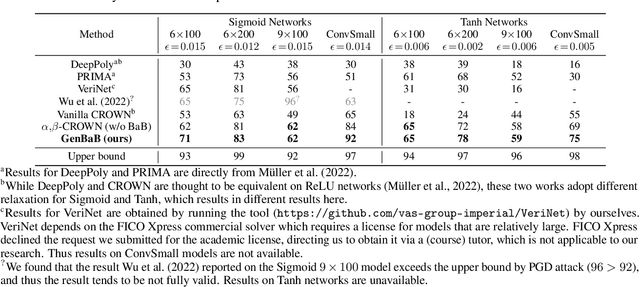
Abstract:Branch-and-bound (BaB) is among the most effective methods for neural network (NN) verification. However, existing works on BaB have mostly focused on NNs with piecewise linear activations, especially ReLU networks. In this paper, we develop a general framework, named GenBaB, to conduct BaB for general nonlinearities in general computational graphs based on linear bound propagation. To decide which neuron to branch, we design a new branching heuristic which leverages linear bounds as shortcuts to efficiently estimate the potential improvement after branching. To decide nontrivial branching points for general nonlinear functions, we propose to optimize branching points offline, which can be efficiently leveraged during verification with a lookup table. We demonstrate the effectiveness of our GenBaB on verifying a wide range of NNs, including networks with activation functions such as Sigmoid, Tanh, Sine and GeLU, as well as networks involving multi-dimensional nonlinear operations such as multiplications in LSTMs and Vision Transformers. Our framework also allows the verification of general nonlinear computation graphs and enables verification applications beyond simple neural networks, particularly for AC Optimal Power Flow (ACOPF). GenBaB is part of the latest $\alpha,\!\beta$-CROWN, the winner of the 4th International Verification of Neural Networks Competition (VNN-COMP 2023).
Lyapunov-stable Neural Control for State and Output Feedback: A Novel Formulation for Efficient Synthesis and Verification
Apr 11, 2024



Abstract:Learning-based neural network (NN) control policies have shown impressive empirical performance in a wide range of tasks in robotics and control. However, formal (Lyapunov) stability guarantees over the region-of-attraction (ROA) for NN controllers with nonlinear dynamical systems are challenging to obtain, and most existing approaches rely on expensive solvers such as sums-of-squares (SOS), mixed-integer programming (MIP), or satisfiability modulo theories (SMT). In this paper, we demonstrate a new framework for learning NN controllers together with Lyapunov certificates using fast empirical falsification and strategic regularizations. We propose a novel formulation that defines a larger verifiable region-of-attraction (ROA) than shown in the literature, and refines the conventional restrictive constraints on Lyapunov derivatives to focus only on certifiable ROAs. The Lyapunov condition is rigorously verified post-hoc using branch-and-bound with scalable linear bound propagation-based NN verification techniques. The approach is efficient and flexible, and the full training and verification procedure is accelerated on GPUs without relying on expensive solvers for SOS, MIP, nor SMT. The flexibility and efficiency of our framework allow us to demonstrate Lyapunov-stable output feedback control with synthesized NN-based controllers and NN-based observers with formal stability guarantees, for the first time in literature. Source code at https://github.com/Verified-Intelligence/Lyapunov_Stable_NN_Controllers.
Defending LLMs against Jailbreaking Attacks via Backtranslation
Feb 28, 2024Abstract:Although many large language models (LLMs) have been trained to refuse harmful requests, they are still vulnerable to jailbreaking attacks, which rewrite the original prompt to conceal its harmful intent. In this paper, we propose a new method for defending LLMs against jailbreaking attacks by ``backtranslation''. Specifically, given an initial response generated by the target LLM from an input prompt, our backtranslation prompts a language model to infer an input prompt that can lead to the response. The inferred prompt is called the backtranslated prompt which tends to reveal the actual intent of the original prompt, since it is generated based on the LLM's response and is not directly manipulated by the attacker. We then run the target LLM again on the backtranslated prompt, and we refuse the original prompt if the model refuses the backtranslated prompt. We explain that the proposed defense provides several benefits on its effectiveness and efficiency. We empirically demonstrate that our defense significantly outperforms the baselines, in the cases that are hard for the baselines, and our defense also has little impact on the generation quality for benign input prompts.
Improving the Generation Quality of Watermarked Large Language Models via Word Importance Scoring
Nov 16, 2023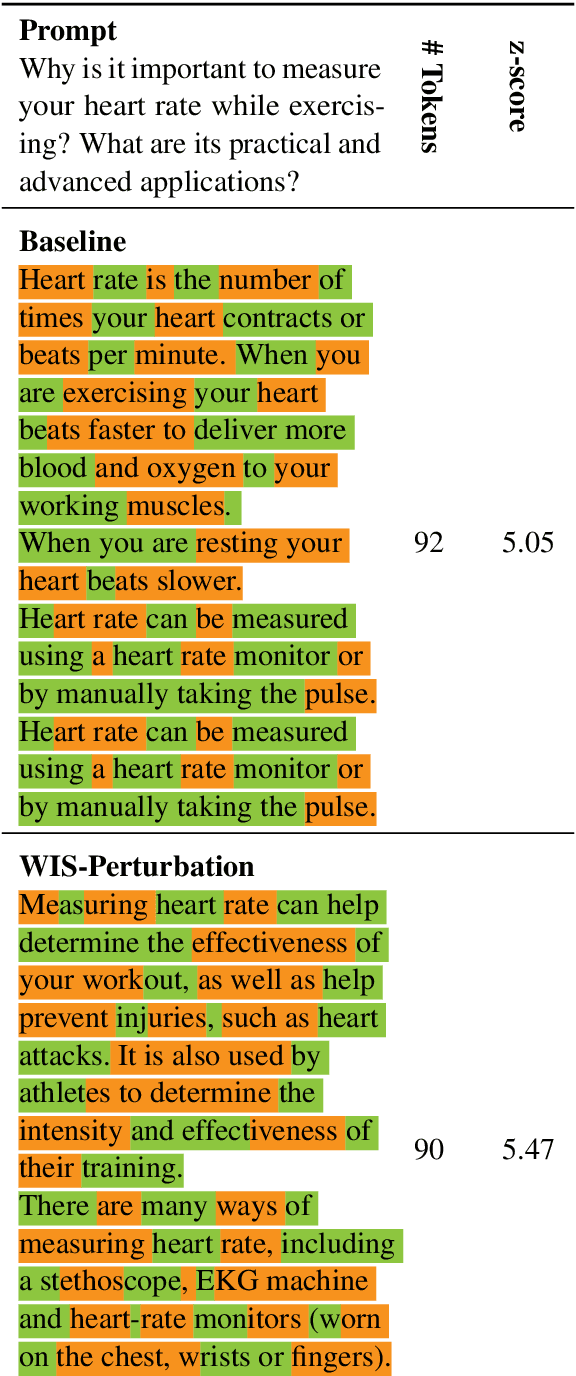


Abstract:The strong general capabilities of Large Language Models (LLMs) bring potential ethical risks if they are unrestrictedly accessible to malicious users. Token-level watermarking inserts watermarks in the generated texts by altering the token probability distributions with a private random number generator seeded by its prefix tokens. However, this watermarking algorithm alters the logits during generation, which can lead to a downgraded text quality if it chooses to promote tokens that are less relevant given the input. In this work, we propose to improve the quality of texts generated by a watermarked language model by Watermarking with Importance Scoring (WIS). At each generation step, we estimate the importance of the token to generate, and prevent it from being impacted by watermarking if it is important for the semantic correctness of the output. We further propose three methods to predict importance scoring, including a perturbation-based method and two model-based methods. Empirical experiments show that our method can generate texts with better quality with comparable level of detection rate.
Red Teaming Language Model Detectors with Language Models
May 31, 2023Abstract:The prevalence and high capacity of large language models (LLMs) present significant safety and ethical risks when malicious users exploit them for automated content generation. To prevent the potentially deceptive usage of LLMs, recent works have proposed several algorithms to detect machine-generated text. In this paper, we systematically test the reliability of the existing detectors, by designing two types of attack strategies to fool the detectors: 1) replacing words with their synonyms based on the context; 2) altering the writing style of generated text. These strategies are implemented by instructing LLMs to generate synonymous word substitutions or writing directives that modify the style without human involvement, and the LLMs leveraged in the attack can also be protected by detectors. Our research reveals that our attacks effectively compromise the performance of all tested detectors, thereby underscoring the urgent need for the development of more robust machine-generated text detection systems.
Effective Robustness against Natural Distribution Shifts for Models with Different Training Data
Feb 02, 2023Abstract:``Effective robustness'' measures the extra out-of-distribution (OOD) robustness beyond what can be predicted from the in-distribution (ID) performance. Existing effective robustness evaluations typically use a single test set such as ImageNet to evaluate ID accuracy. This becomes problematic when evaluating models trained on different data distributions, e.g., comparing models trained on ImageNet vs. zero-shot language-image pre-trained models trained on LAION. In this paper, we propose a new effective robustness evaluation metric to compare the effective robustness of models trained on different data distributions. To do this we control for the accuracy on multiple ID test sets that cover the training distributions for all the evaluated models. Our new evaluation metric provides a better estimate of the effectiveness robustness and explains the surprising effective robustness gains of zero-shot CLIP-like models exhibited when considering only one ID dataset, while the gains diminish under our evaluation.
Efficiently Computing Local Lipschitz Constants of Neural Networks via Bound Propagation
Oct 13, 2022

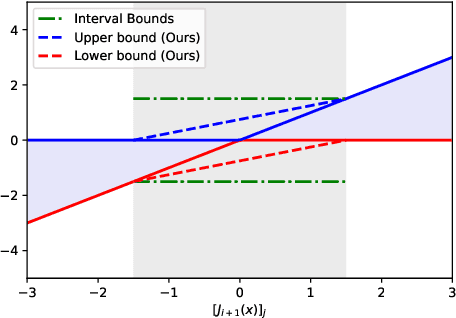
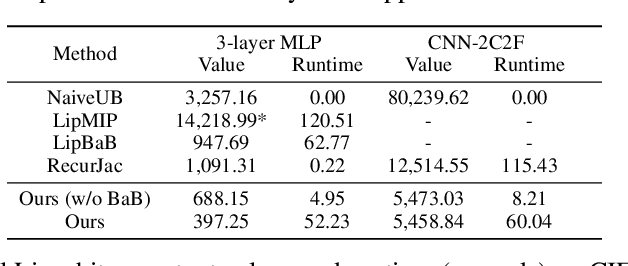
Abstract:Lipschitz constants are connected to many properties of neural networks, such as robustness, fairness, and generalization. Existing methods for computing Lipschitz constants either produce relatively loose upper bounds or are limited to small networks. In this paper, we develop an efficient framework for computing the $\ell_\infty$ local Lipschitz constant of a neural network by tightly upper bounding the norm of Clarke Jacobian via linear bound propagation. We formulate the computation of local Lipschitz constants with a linear bound propagation process on a high-order backward graph induced by the chain rule of Clarke Jacobian. To enable linear bound propagation, we derive tight linear relaxations for specific nonlinearities in Clarke Jacobian. This formulate unifies existing ad-hoc approaches such as RecurJac, which can be seen as a special case of ours with weaker relaxations. The bound propagation framework also allows us to easily borrow the popular Branch-and-Bound (BaB) approach from neural network verification to further tighten Lipschitz constants. Experiments show that on tiny models, our method produces comparable bounds compared to exact methods that cannot scale to slightly larger models; on larger models, our method efficiently produces tighter results than existing relaxed or naive methods, and our method scales to much larger practical models that previous works could not handle. We also demonstrate an application on provable monotonicity analysis. Code is available at https://github.com/shizhouxing/Local-Lipschitz-Constants.
On the Convergence of Certified Robust Training with Interval Bound Propagation
Mar 16, 2022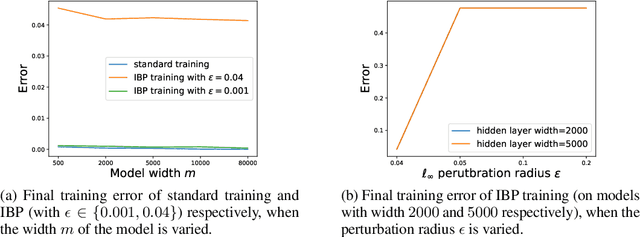
Abstract:Interval Bound Propagation (IBP) is so far the base of state-of-the-art methods for training neural networks with certifiable robustness guarantees when potential adversarial perturbations present, while the convergence of IBP training remains unknown in existing literature. In this paper, we present a theoretical analysis on the convergence of IBP training. With an overparameterized assumption, we analyze the convergence of IBP robust training. We show that when using IBP training to train a randomly initialized two-layer ReLU neural network with logistic loss, gradient descent can linearly converge to zero robust training error with a high probability if we have sufficiently small perturbation radius and large network width.
 Add to Chrome
Add to Chrome Add to Firefox
Add to Firefox Add to Edge
Add to Edge